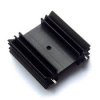Musicmanager
Well-Known Member
Morning Guys
A couple of weeks ago I was browsing ETO when I came across a thread involving one of the 'Super Moderators' from Derbyshire extolling the virtues of Bangood.com and in particular a 0 - 30v power supply and a combined volt & ammeter display. Well, if it's good enough for him, it's good enough for me I thought, so I promptly ordered one set which has now arrived. I've since ordered another set and I've purchased a dual tap 240/24vac 250va transformer with the intention of building a dual output bench power supply.
I've noted that many of the ready made PSU's have a discreet output for 5vdc and 12vdc and there must presumably be good reason for that ? If I'm to add discreet outputs to my PSU would I be best to use Buck Converters - there are so many different schematics for buck converters on the web that seem to work in several different ways so I'm not sure which one to follow.
Anybody who is not fed up with me yet and is consequently willing to offer advice ?
Thanks
S
A couple of weeks ago I was browsing ETO when I came across a thread involving one of the 'Super Moderators' from Derbyshire extolling the virtues of Bangood.com and in particular a 0 - 30v power supply and a combined volt & ammeter display. Well, if it's good enough for him, it's good enough for me I thought, so I promptly ordered one set which has now arrived. I've since ordered another set and I've purchased a dual tap 240/24vac 250va transformer with the intention of building a dual output bench power supply.
I've noted that many of the ready made PSU's have a discreet output for 5vdc and 12vdc and there must presumably be good reason for that ? If I'm to add discreet outputs to my PSU would I be best to use Buck Converters - there are so many different schematics for buck converters on the web that seem to work in several different ways so I'm not sure which one to follow.
Anybody who is not fed up with me yet and is consequently willing to offer advice ?
Thanks
S


